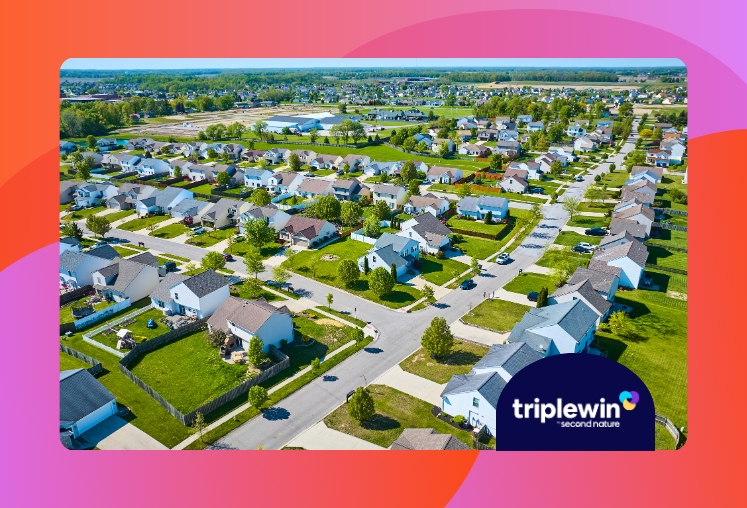What we'll cover
What is an investor benefits package (IBP)?
Why call it an "Investor Benefits Package™️"?
What’s included in an investor benefits package?
How can investors and property managers benefit from an investor benefits package™️?
Should you make an investor benefits package mandatory?
Final thoughts about an investor benefits package
An Investor Benefits Package™️ (IBP) in property management is a suite of products, services, and benefits offered by property management companies to property investors. Just like a resident benefits package is a way to drive value for residents, investors, and property managers, the IBP™️ is an innovative approach to property management that focuses on driving value for an investor's assets and turning that value into profit for the property management company.
In this article, we’ll dig into the different features that an Investor Benefits Package™️ can include, and how those benefit not just investors, but property managers and residents, too.
What Is an Investor Benefits Package™️ (IBP)?
As stated above, an Investor Benefits Package™️ (IBP™️) is a comprehensive suite of services that offer property investors higher quality property management, stability, and profit. It's referred to by some as an Owner Benefit Package, but we'll get into that in a moment.
An IBP™️ typically includes concierge-level services beyond basic property management – such as property insurance policies, eviction guarantees, rent guarantees, maintenance plans, asset performance reports, etc. These services are aimed at maximizing the investor’s assets, stability and convenience, profitability, and peace of mind in managing their properties. They're commonly managed through an investor experience platform to securely manage and monitor the performance of these assets online, which we'll discuss later.
The first step to outlining an IBP™️ is to define what your basic management fee means and covers. If the answer is, that it’s collecting rent, handling maintenance, and general communication – does that include maintenance coordination or is that a separate fee? Does it include asset reporting or is that an additional service?
In your management agreement, define what the management fee is, what it covers, and how much it is. An IBP™️ can be an effective tool for articulating the new and differentiated things that an investor wouldn’t be able to do on their own and that you are offering beyond basic property management. Articulate your unique and differentiated services (IBP™️) and use that as a tool for positioning and charging for what it’s worth.
Why Call it An "Investor Benefits Package™️"?
Here at Second Nature, we like to refer to “tenants” as “residents” and “landlords” or “owners” as “investors.” This humanizes the relationship between the resident and investor and is important in what we’re trying to accomplish: a "Triple Win" for all involved.
That's why we're referring to an "Investor Benefits Package" rather than an "Owner Benefits Package."
Winning as an investor is so much about attracting and screening for people who are most likely to be the best residents and delivering a professional resident experience that they will pay for and stay for.
An Investor Benefits Package™ is instrumental to getting to that Triple Win, and we'll turn to that now.
What’s Included in An Investor Benefits Package™️?
An Investor Benefits Package™️ should include a range of solutions to help deliver consistency, insight, and asset protection to a property owner’s portfolio.
After all, professional property managers don’t have to be functional managers of a home – they can be strategic partners in the management of financial assets. Again, you might hear services similar to the IBP™️ called an “owner benefit package,” but at Second Nature, we believe that the “investor” term is useful in encouraging a longer-term mindset, and emphasizes the economic value professional property management can bring. Contrast this with the notion of an owner-benefit package, which doesn't share the same mindset.
According to Eric Wetherington, VP of Strategic Initiatives at PURE Property Management:
“As property managers, we need to think more like asset managers. This client made an investment, and we should be guiding that client through managing that investment, not just collecting rent.”
To build and manage a winning IBP™️, property managers need an Investor Experience Platform that unlocks scalable product and service customization, digitized onboarding, accounting policy automation, and more. In addition, Investor Experience Platforms provide transparency and convenience for your investors. Here are some of the most valuable services that property managers can offer through an innovative Investor Benefits Package™️.
Property insurance program
Similar to offering a renters insurance program through an RBP in the lease agreement, property management companies can offer an insurance plan to investors to cut costs and ensure the safety of their assets.
Most management agreements will include the requirement that the investor carries insurance on the property and that the property manager is additionally insured. But what if you as the property manager could help manage that for the investor – at scale?
Property Insurance for investors should have dynamic pricing based on individual investors’s property portfolio and needs. The benefit beyond flexibility is the savings they’ll see on their premiums while also getting insurance that’s tailored to the needs of their specific property class. At Second Nature, we work primarily with single-family rental properties and small multi-family residences.
Property Insurance Programs can bring scale that will drive economic value for the investor over what they could get retail on their own. They’d still have the option to go get their own insurance that meets requirements, but they can pay you a small fee to manage it for them.
Rent guarantee
An IBP™️ can include a number of financial guarantees to protect property investors and drive ancillary revenue for PMCs.
A rent guarantee, or rent protection, ensures a consistent rental income to investors by protecting them against resident defaults or non-payment of rent. If a resident fails to pay rent, the property management company covers the unpaid amount and takes necessary steps for eviction or collection, providing financial security and minimizing the risk for property owners.
Rent guarantees work for professional property management companies that have enough properties to balance the loss of rent if a resident doesn’t pay. The risk is low and the additional profit from fees for this guarantee can have a very high ROI while driving satisfaction and stability for the investor.
Plus, if you’re using services in an RBP to help incentivize on-time rent payments, you’ll rarely find yourself out in the cold.
Eviction protection guarantee
An eviction protection guarantee also goes beyond the normal scope of property management services and can be used as a secondary source of revenue.
Eviction Protection is a service provided by property management companies to property investors that offers additional security and financial protection in the event of an eviction.
Under this guarantee, the property management company assumes the costs associated with the eviction process, including legal fees and court expenses. It helps alleviate the financial burden on property investors and provides peace of mind by ensuring that they are safeguarded against potential losses resulting from resident evictions.
The eviction guarantee helps protect property owners from the complexities and potential costs associated with evictions, ensuring a smooth and efficient resolution to tenant-related issues.
Pet guarantees & other guarantees
A pet guarantee is a service offered by property management companies to property investors that aims to address any potential issues related to allowing pets in rental properties. It typically involves implementing policies and procedures to ensure responsible pet ownership, such as thorough pet screening, pet agreements, and collecting additional pet deposits or fees.
The pet guarantee may also include services like pet damage insurance or assistance with pet-related issues during the lease term. It provides property investors with a framework to accommodate residents with pets while minimizing risks and maintaining the condition of the property.
For many residents, finding a pet-friendly apartment increases retention and profitability. They’re willing to stay longer and pay more for a pet-friendly place. And–get this–pet damage is less likely to happen than damage from kids! It’s not a huge risk to the asset, but can provide a big benefit in terms of satisfied, longer-term residents.
Maintenance plan
Home warranties are a four-letter word for property managers. They’re a massive headache to deal with, and yet there’s high demand for them among property investors. Because of that, most property managers charge a fee for home warranties, for each they have to file.
Imagine if there was a world where home warranties weren’t needed.
Here’s the thing: Professional property managers already have the vendor network and the know-how to coordinate maintenance jobs. What they don’t usually have is a product that’s priced to give the investor the experience they want.
Let’s say right now an investor is paying $50 a month for a cheap home warranty. The warranty only covers 40% of issues and it creates all these extra people and friction in the middle. For anything moderately significant that goes wrong with a property, PMCs generally must contact the investor for permission to get work done. It’s all a massive hassle and loses time in maintenance requests that leave residents frustrated.
What if there was a product that costs, say, $150 to $200 a month but it actually covered everything? Instead of having sudden expenses and emergencies, this maintenance plan smooths out the experience and makes it more predictable for the investor. For PMs, it means taking the initiative on fixes without waiting for approval. Imagine a world where you didn’t have to get owner approvals for 95% of maintenance issues – because they’re already budgeted for and already paid for. For residents, it means better maintenance, and faster.
Another Triple Win!
Asset performance reports
Another piece focuses on property managers as asset managers.
Think about any investment app, like Robinhood, Acorns, etc. You can log in to these apps any time, 24/7, and see how your stock and investments are performing. In most investment classes, you can see in real time how your assets are performing. Why shouldn’t property investors have that as well?
An IBP™️ can include exactly that: a dashboard or online portal that shows investors regular reports on how their property is doing. They could get updates on the value of their home over time, the home price appreciation, rent price over time, and project rent growth, typically maintenance costs and how they’re doing against that, and more.
Resident Benefits Package
Another piece to include in your IBP™️ is to highlight the benefits of your resident benefits package to your investors. Explain how features like a filter delivery program protect their assets and reduce HVAC repair costs. Show how a renters insurance program can ensure coverage and protection. Give numbers on how credit reporting incentivizes on-time rental payments and helps ensure financially stable renters. Explain how a movie-in concierge saves both time, headache, and money.
Each of the pillars of an RBP is critical to encouraging better resident behavior, increasing renter retention and lease renewal rates, reducing vacancies, and more – all primary goals for a property investor.
A note about Rent Advance Programs
There’s been due buzz about “Rent Advance” offerings, though many advise caution when approaching this financial product.
It works in some ways like cash advance programs, which can satisfy urgent needs, but not be more valuable for anyone long term. The way it works is PMs offer to send a year of rent upfront to the investor in a big chunk, and collect monthly from the resident. The investor typically pays a 5-10% premium on the advance, which can be their entire expected return. So the question becomes, where do they put that cash to get a better return instead?
Another thing to think about is who would actually use this product. Investors who don’t have enough cash on hand? How does that benefit anyone in the long run? What happens when there’s a big maintenance bill later? Does this encourage better decisions and practices by the investor?
To date, there’s been pretty low adoption of this program, which is another sign it may not be hugely beneficial to everyone involved. But plenty of innovations start that way, evolve, and find traction. One case where it might be a value generator is if an investor is looking to take a cash advance and put it toward a down payment for another house. That would benefit the property manager as well, promising more business, and the PM could offer a lower rate for getting more properties to make the financing more attractive than hard money loans or other alternatives.
The jury is still out here, it’s an interesting one to track.
How Can Investors and Property Managers Benefit From an Investor Benefits Package™️?
Investors and property managers can benefit from an Investor Benefits Package™️ in several ways. They’re also great for residents in the sense they build more stability and quality into the renting process.
Here are just some of the benefits of an IBP™️.
Enhanced investor attraction
An Investor Benefits Package™️ provides incentives and advantages that can attract more investors. Financial guarantees and protections against the risks associated with evictions or late payments can increase stability, while services like a maintenance plan can ensure premium care of their property assets without increasing their workload. By offering attractive perks, property managers can differentiate their offerings and generate greater investor interest.
Increased investor retention
Both IBP™️s and RBPs help build loyalty with residents and investors. By fostering a strong relationship and demonstrating ongoing value, property managers can build trust and loyalty among investors, and retain them over the long term. IBP™️s help establish the stability, transparency, and asset growth for a real estate investment that an investor hopes to achieve.
Improved property performance
An Investor Benefits Package™️ can also contribute to improved property performance. For example, by offering discounted property management fees or access to professional services at reduced rates, property managers can help investors optimize their returns and reduce costs. Additionally, incentives such as rent guarantees or eviction protection can mitigate risk for investors and attract more capital to the property.
Streamlined communication and transparency
A well-designed Investor Benefits Package™️ facilitates effective communication and promotes transparency between property managers and investors. This can involve regular reporting on financial performance, property updates, and the sharing of relevant market insights. Transparent and consistent communication builds trust and confidence among investors, fostering a positive and long-lasting relationship.
Competitive advantage
A comprehensive Investor Benefits Package™️ can give property managers a competitive edge in the market. When investors have access to exclusive benefits and advantages, they are more likely to choose a property managed by a company that offers a compelling package – and to recommend it to others. Say hello to increased investment inflow and a stronger market position for your PMC.
Should You Make an Investor Benefits Package Mandatory?
The first thing most property managers ask us when we’re talking about an RBP or an IBP™️ is: Should I make this mandatory for all investors or do I make it a flexible opt-in/opt-out program?
Unlike RBPs, where best practices are more proven and established, different PMs are taking different approaches with their IBP™️s. Some have a mandatory level of service set at a flat price. Others may say they’re fine offering a base level of service without these differentiated products, giving investors the choice to simply pay a baseline management fee and opt out of the IBP™️ premium service.
Some may offer a baseline to all investors and then give them the chance to opt in for premium IBP™️ services.
There are a lot of ways to do it. With the RBP, we’ve found that making it mandatory does not generate nearly as much pushback as people expect – and can be a strong value add overall.
About an Investor Benefits Package™️ by Second Nature
The Investor Benefits Package™️ is an innovative way to generate ancillary income and create more value for investors and residents. Similar to Second Nature’s premier Resident Benefits Package, the IBP™️ can deliver high-quality service for investor experience – and help create a triple win for investors, residents, and property management companies.
The IBP™️ reinforces the value of a professional property management company for investors and helps differentiate you from the crowd. Stay tuned to learn more about the latest in the IBP™️ space, or learn more about how a resident benefits package can launch a whole new level of value for your PMC.




